
"Can't I just add gluten to my all-purpose flour and make bread?" Betty asked. The short answer is "Yes". But there may be a better answer.
There is a lot of difference in flours. The home-storage company,
Prepared Pantry, tried over 20 different kinds of flours trying to find the right flours for their formulas, especially for their bread machine mixes. They found it was amazing how much differently those flours performed.

The bottom line: You get better and more consistent results if you use a flour designed for your purposes, especially with breads. Try several different flours until you find one that fits your recipes and that you like. Then stick with that flour.
The White Flours
By far, the western world consumes more white flour than any other—bleached or unbleached, bread, all-purpose, self-rising, cake, and pastry. We can buy flour made with soft Southern wheat or hard winter wheat. They are all different, each with an intended purpose. The choice of flour will make a profound difference in most baked goods.
Bleached or Unbleached?

Chlorine is the common bleaching agent used to whiten flour (though some millers use benzoyl peroxide). Many store breads use bleached flour to obtain the whiteness that we associate with commercial white bread. While the FDA has approved the use of chlorine in flour, you may prefer to avoid the additives and use flour that has not been bleached. It tends to damage the proteins in flour and weaken the gluten structure in bread.
The natural tone of unbleached wheat flour is cream-colored. If you don’t mind the ivory or cream color of products made with unbleached flour, by all means use that. If you switch from bleached to unbleached flour in your bread recipes, be aware that the two flours may exhibit different performance characteristics and you may need to make minor changes in the recipe.
Bromated or Unbromated?

Bread flours have to age or oxidize before they perform well. The time and expense of natural oxidation is not practical in commercial operations and the results are not often uniform. So the industry speeds the process along by using bromates. The FDA has ruled bromates to be safe and legal (though California outlawed bromates in 1991 as a possible carcinogen and most of Europe will not allow bromates). If you are not comfortable with bromates, look for flour that has been treated with ascorbic acid (Vitamin C) or other chemicals instead of bromates.
Bread, All-Purpose, Self-Rising, Pastry, or Cake Flour?
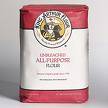
Bread flours, all-purpose flours, cake and pastry flours dominate grocery store shelves. Bread flours have a high protein content--10% to 14%--necessary to give bread the chewy texture and open “crumb” appearance that we cherish in our breads. Cake and pastry flours have a low protein content to create the soft, crumbly, melt-in-your-mouth texture that we prefer in our desserts.
All-purpose flour is a compromise between the protein content in bread flours and the protein in pastry flours. All-purpose flours make acceptable bread and pastries but more specialized products are more reliable performers in either spectrum, which is why you’ll rarely see all-purpose flour in a commercial bakery.
Self-rising flours have salt and leaveners added. Some bakers use self-rising flour for their favorite biscuits.
Cake flour is almost always bleached; pastry flours are usually unbleached. Don’t hesitate to use unbleached pastry flour for cakes. Unbleached pastry flours make wonderful cakes but white cakes will be ivory, rather than white, in color. Of course, with a yellow or chocolate cake, who cares?
The Whole Grain Flours

Whole Wheat: The wheat kernel is composed of three parts: the bran which forms the hard outer coating of the kernel, the smaller germ which is the embryonic portion of the kernel as the yolk is to an egg, and the starchy endosperm. In the milling of white flour, the bran is cracked from the kernel and discarded and most of the germ is removed leaving the endosperm.
In whole wheat flour, both the bran and the germ are left with the flour. Since the germ has a high fat content and fat can go rancid, whole wheat flours are much more likely to spoil. Also, since the flour is composed of the entire wheat kernel, whole wheat flour is not enriched with vitamin additives as white flour is. (The federal government specifies the addition of vitamins to white flour.) Whole wheat flour comes in either a fine or coarse ground texture.
Most but not all of the “brown” breads produced commercially are made from a blend of white bread flour and fine ground whole wheat with only about
40% of the flour content being whole wheat. The white flour tempers the whole wheat providing a slightly milder taste without the bitterness that whole wheat sometimes carries. The white flour also creates a stronger gluten structure since bread flour typically has a higher protein content than whole wheat alone. Additionally, the bran in whole wheat has sharp edges that cut gluten strands as it is kneaded.
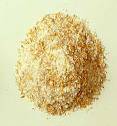 Graham Flour:
Graham Flour: It’s whole wheat flour. The FDA’s Code of Federal Regulations allows any whole wheat flour to be called graham flour. So it depends on the miller; read the package carefully to see just what you are getting.
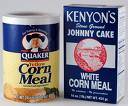 Cornmeal:
Cornmeal: Like wheat flour, can be purchased with or without the germ and in a fine or a coarse ground form. For cornmeal with the germ removed, look for the term “degerminated” on the label. Degerminated cornmeal keeps longer--since the fatty germ is removed--but is not as nutritionally complete as cornmeal with the germ.
The word “meal” refers to products that are not as finely ground as flour. Both cornmeal and corn flour are available. Polenta is usually coarsely ground.
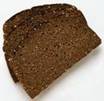 Rye Flour:
Rye Flour: Used extensively in pumpernickel and rye breads. It can be purchased in light rye, medium rye, and dark rye flours. White rye is especially prized by the bakers of artisan loaves and creates a mild, uniquely-flavored bread with a taste that is described as being sourdough-like.
Because rye proteins do not form the gluten strands necessary to create structure, bread made with rye flour alone is heavy and dense. Accordingly, when making breads with rye flour, add two to three times as much high protein content bread flour as rye flour. Often extra wheat gluten is added.
The flavor most of us associate with rye bread comes from the caraway seeds in the bread. If your family says they don’t like rye bread, make it without the caraway seeds, then they’ll probably like it.
 Oats:
Oats: Used in baking in various forms: rolled, quick, steel cut, and flour. (Steel cut oats are quick oats that are not flattened.) Oat bran can also be purchased. Oat products are most generally used with chemically leavened products like scones and muffins. Rolled oats added to yeasted bread make for a wonderful chewy texture and moistness.
 Buckwheat Flour:
Buckwheat Flour: Often used in pancakes and sometimes in breads. Buckwheat is not really a grain but a seed. Because there are no proteins to form gluten, buckwheat adds little structure to the baked product. It is most commonly used in pancakes but is sometimes added to breads.
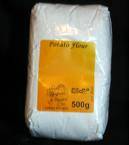 Potato Flour:
Potato Flour: An important component in the baker’s arsenal. Unlike wheat flour, it is hygroscopic—that is, it attracts water instead of dries out—so that the staling process in breads is retarded or slowed. One tablespoon of potato flour to two cups of wheat flour will extend the life of your bread and keep it moist.
So what flour should I buy?
Buy flours for their intended uses—bread flour for breads and pastry flours for pastries plus all-purpose flours for gravies and other general uses. Keep in mind that most recipes—except bread recipes--were developed with all-purpose flour since that is what is common in nearly all kitchens. Try using all-purpose flour for a new recipe and then switch to a specialty flour after becoming familiar with the recipe.

Also, try different brands (there is a surprising difference in performance between brands), then stick with what works. Name brands tend to consistently hold to a specification where less expensive brands tend to vary from season-to-season and sometimes, even lot-to-lot. If you really want to broaden your selection, make friends with a baker (they have a vast array of flours available, each with its own specification); buy a bag or two and try it. Your baker will be able to supply you with a detailed specification so that you can see what you are getting.
(Information from
The Prepared Pantry)
Contribute to the Cook'n Club!
DVO would love to publish your article, prose, photography and art as well as your cooking, kitchen and nutrition tips, tricks and secrets. Visit the Newsletter Submission / Win Win for All section in our Forum for more information and details.



